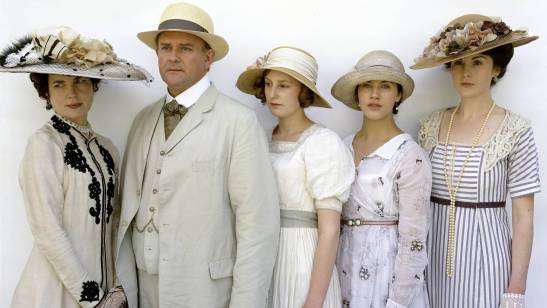
With their minute attention to detail, nowadays it seems like watching a historically-set movie or TV show is about as close as you can get to traveling back in time. But as fans and scholars have pointed out, no matter how good they might look, one way most historically set entertainment fails to correctly capture the past is with language.
A common target for this kind of criticism is the series Downton Abbey. While its sets and especially its costumes seem to evoke the show’s 1912-1923 span more or less without fail, people seem to adore finding linguistic anachronisms in it. If you haven’t seen the show, rest assured, these usually aren’t extremely obvious (although many viewers were shocked by one character saying to another “I’m just sayin’…”). But they do exist, and it’s not just armchair nitpickers who’ve noticed.
Ben Schmidt is an historian who created a program that searches through data from online archives like Google Books to compare the language of shows like Downton Abbey with vocabulary that was actually used in the time they’re set. The results of Schmidt’s research, which he’s also used on shows and movies like Mad Men, Lincoln, and 12 Years a Slave, among others, is fascinating.
Of course, you could argue, as some people have, that using printed material to check how previous generations spoke isn’t really fair; after all, written and spoken language can be very different. Schmidt has also thought about this, and has used other resources, like contemporary films and radio broadcasts, as well as surveillance recordings from the ‘60’s-era White House, in his data, as well. Still, as this podcast about Schmidt’s work points out, there is one area where his system isn’t helpful: obscenities. In addition to their not generally being used in old movies and radio shows, anyone who’s read an older book knows that they also weren’t printed, or were, at best, usually only suggested by the first letter of the word, followed by a dash (or, later, by a fun series of punctuation marks).
Some people have another issue with the value of what Schmidt has done. About ten years ago, when the movie Moulin Rouge! was released, I went with some friends to hear director Baz Luhrmann speak about the film. At one point he described how, while Satine (played by Nicole Kidman) makes her big entrance in what looks like a fancy diamond-encrusted swimsuit in the movie, a real dancer in the Moulin Rouge in 1899 would have merely been swathed in flesh-colored bandages. But, Luhrmann explained, this wouldn’t have been dazzling or particularly shocking to an audience today – it would merely have been weird. He had to interpret the sensation of seeing such a thing for a contemporary crowd.
There are people who feel that, when it comes to language in period pieces, this concept should be the rule, as well. There’s another advantage to this approach: as Geoff Nunberg points out in this compelling NPR segment, some words that were used one way in the past have very different connotations today. So it seems that sometimes, accuracy needs to be sacrificed for clarity.
Overall, I agree. But at the same time, I definitely appreciate when writers try to immerse us in the past as much as they possibly can. It seems that the ideal historical translation – like any kind of translation – is about balance. As Nunberg puts it so well: “A historical novel or screenplay should give us a translation, not a transcription.”
